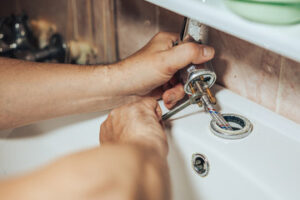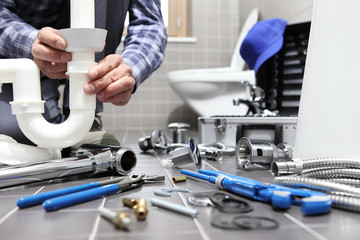If your faucet is spitting, spraying, or dripping, you probably need to replace one or more of its parts. Having the right parts on hand is crucial, and knowing the order to reassemble them is important.

Start by shutting off the water supply to the faucet using the shutoff valves under the sink or at your main home plumbing shutoff valve. However, contact a plumber if you need some professional help.
Keeping a stock of replacement parts will help you keep your faucets running efficiently for years. We carry a wide range of parts, from stems and cartridges to supply lines. You’ll also find handles, inserts, and aerators, plus washers, pipe cements, and smart water leak detectors. Whether you have a single- or double-handle faucet, we’ve got the replacement parts to keep it in perfect working order.
One of the most important parts of a faucet is the handle. It’s the most visible component, so it needs to be sturdy and comfortable to hold. Our selection of faucet handles includes lever, cross, and blade styles to fit a variety of faucet finishes. We also offer a wide selection of escutcheon plates, which are used to cover up unused holes in the countertop in single-hole faucet assemblies.
The cartridge is another critical faucet part, assisting with hot and cold mixing and controlling the water temperature. It is often made of plastic and metal, and it will wear out over time. We carry a wide range of cartridges, including this Moen replacement, which has been sourced directly from the manufacturer and is designed for use in two-handle faucets. To install this cartridge, refer to the parts diagram for your model and use an Allen wrench and a pair of pliers.
We also carry a variety of replacement hoses for kitchen and bathroom faucets, which are used to connect the faucet to your home’s water supply. These hoses are available in different lengths and styles, so you can choose the right one for your specific faucet.
Ordering Parts
If you’re able to determine the brand of faucet and the type (cartridge or ball) you have, you can order replacement parts online. Some hardware stores and home centers carry cartridges for specific faucet models, while others may only have them available from a plumbing supply specialist. If you have a cartridge-style faucet, make sure you know whether the leaking side is the hot or cold side so you can buy the correct replacement cartridge.
Start by shutting off the water. Once the faucet is dry, you can begin to remove the handle. If there is a decorative cap on the top of the handle, pry it off with a flathead screwdriver and expose the screw underneath. Loosen and remove the handle screw, and set it aside with the other handle components you’ll be removing. Be sure to lay them out in the order you removed them so you can keep track of which pieces go where when you’re ready to reassemble.
Once you’ve removed the handles and the spout, loosen the retaining nuts on each of the faucet stems. If you can’t find the replacement valve stems in your parts catalog, take the old ones with you to a local home improvement store or hardware store so they can match them up with a photo. Then purchase the appropriate replacements and any other needed repair parts, such as a new set of rubber O-rings for the cartridge or a seat washer to replace the worn one on the faucet body.
Depending on the problem, you may have to order more specific parts, such as an inlet or outlet seal or the cartridge itself. In most cases, however, a few simple steps can fix a leaky faucet. If you’re not confident enough to attempt the repairs yourself, call a professional plumber for assistance. They can quickly and inexpensively remove your faulty faucet and install a new one for you. And they’ll be stocked with the right parts to ensure your faucet is working properly when they leave. The next time you turn on the water, it should flow smoothly, expelling a small amount of air through the spout.
Installation
Faucets are found in bathrooms, kitchens, and laundry rooms throughout your home, providing a stream of water for tasks such as bathing and cleaning. Like any other household fixture, faucets can develop problems, including leaks, due to sediment buildup and corrosion. Although some issues can be easily corrected with a few replacement parts, others require more extensive work, such as replacing the valve seat or spout O-rings.
Start by shutting off the water supply to your dripping faucet. This is usually done by turning the lever or knob on the faucet handle clockwise until it stops. Once the water is turned off, open the drain and place a bucket or towel under the faucet to catch any water that might be dripping from the pipe connections underneath.
Examine the faucet handle to determine how it is mounted. Some handles have a decorative cap that covers a screw on the top, while others have a set screw on the side or back of the handle base. Once you know how to remove the handle, use an Allen wrench or screwdriver to loosen the set screw and then pull off the handle. Set the handle aside, keeping track of which part is removed from which position so you can reassemble it in the proper order.
If the faucet has cartridge stems, you will need to take out the old one to inspect the O-rings and the cartridge itself. Some cartridges have tabs that fit into notches on the faucet body to secure them, while others have a brass screw at the top of the shaft that helps hold the cartridge in place. Once the old cartridge is removed, note how it is positioned so you can install the new one exactly the same way.
If your faucet has a ball or ceramic disk-type stem, you will need to loosen the retaining nuts that hold the stems in place with a wrench. Once the nuts are loose, you can pull out the old stems and clean the spout and spout ports of any sediment or mineral deposits. Once all the ports are free of debris, replace the spout O-ring and the diverter O-ring, coating them with packing grease to protect them from hot water.



